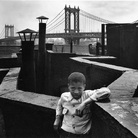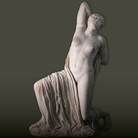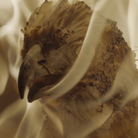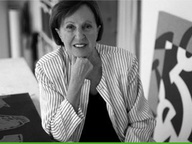Antoni Clavé. Alchimia della materia

Antoni Clavé, A Domenikos T, 1965
Dal 6 May 2015 al 31 October 2015
Venezia
Luogo: Scoletta dei Battioro
Indirizzo: Salizada San Stae
Telefono per informazioni: +39 051 235843
E-Mail info: info@maggioregam.com
Sito ufficiale: http://www.scolettabattioro.it
Antoni Clavé (Barcellona 1913 – Saint Tropez 2005), è tra gli artisti più interessanti su cui si accenderanno i riflettori durante la 56. Biennale di Venezia. È infatti protagonista di una grande retrospettiva organizzata dalla Galleria d'Arte Maggiore di Bologna presso i magnifici spazi della Scoletta dei Battioro, sul Canal Grande. Tra i maggiori protagonisti dell'arte dello scorso secolo, Clavé è un artista dalla personalità poliedrica capace di scarti inaspettati e di inesauribile complessità, uno spirito curioso e sempre voltato verso la sperimentazione. La mostra veneziana vuole mettere in luce la continua sfida ai processi artistici tradizionali operata da Clavé per tutto l'arco della sua carriera, spaziando attraverso le diverse produzioni dell'artista.
Pochi sono gli artisti che nel corso del XX° secolo sono riusciti, come Antoni Clavé, a coniugare un'altissima coerenza artistica e intellettuale con una mai sopita tendenza alla sperimentazione. Ed è proprio quest'unità, nella complessità, ad essere protagonista della mostra organizzata durante la 56. Biennale d'Arte di Venezia. Aperta dalla grande scultura in bronzo, “Guerrier et bouclier”, in esposizione si troveranno gli oli in omaggio al grande maestro Greco, assieme alle sperimentazioni degli anni '70 a tecnica mista, con l'utilizzo del collage e dei rilievi su foglia d'alluminio e le grandiose tele degli anni '90. Se la scultura ha per tema la figura umana – un guerriero, ultimo erede di una civiltà scomparsa, una composizione ricca di mistero eppure pervasa di ironia -, le opere degli anni '70 recano, letteralmente, in assenza le tracce degli oggetti che compongono la quotidianità dell'artista. Si prosegue poi con gli omaggi a Greco, ripetuto in varianti sempre diverse, come un leitmotiv o un'ascendenza che pervade la sua produzione. Si vede così come Clavé sia preso in una riscrittura della proprie influenze, come sia capace di far proprio l'esempio dei maestri, perché anch'egli maestro. Nelle opere più recenti, grandi tele a olio, la figurazione si perde, diluitasi in una mai perduta gestualità pittorica, in cui si inseriscono collage e si intersecano tecniche diverse: ogni decennio apre a nuove sperimentazioni, ogni tecnica è assunta dall'artista come mezzo per conoscere ed esprimere il mondo. Vu à Vicky Street, con il suo rosso - colore simbolo per chi conosce l'opera dell'artista – presenta una gestualità non furiosa, ma guidata da un'istintualità artistica, pensata, dove il pennello segna le linee del mondo e del pensiero. In queste opere, dalle notevoli dimensioni, rivivono elementi e suggestioni che hanno pervaso tutta la carriera di Clavé, i suoi colori notturni, la sua capacità di far convivere la materia con l'intelletto, il mondo con la sua sublimazione artistica, la tradizione storica con le scoperte dei suoi viaggi, come quello compiuto negli anni '80 a New York dove scopre i muri, i manifesti, i graffiti che diventano parte dell'opera d'arte.
Mai come in Clavé vediamo un'applicazione di quella che Henri Focillon chiamò «poesia dell’azione»; se ci dovesse essere una conferma che l'animo prende forma attraverso le mani e le mani sono la forma dell'animo d'artista, la produzione dell'artista sarebbe il documento decisivo, un elogio della mano, per dirla con le parole del critico francese. In Clavé, il gesto è la prosecuzione del pensiero, un'organizzazione del caos, una chiamata a cui l'artista non abdica mai, fino alla fine della sua carriera. Clavé indaga, dunque, il fondo della realtà con gli oggetti, con gli strumenti o con un'idea e riscopre laggiù la grazia che si mostra nel disordine dirompente: così le macchie chiare e le punte di rosso che illuminano di bagliori inaspettati i toni bruni, il nero, il grigio e il blu di Prussia, come stelle. Una produzione generosa e irrompente, ricca di svolte e fatta di sperimentazioni ardite con tanti slanci verso il nuovo e l’inconsueto, il tutto filtrato dal ricordo della calda terra natale.
Pochi sono gli artisti che nel corso del XX° secolo sono riusciti, come Antoni Clavé, a coniugare un'altissima coerenza artistica e intellettuale con una mai sopita tendenza alla sperimentazione. Ed è proprio quest'unità, nella complessità, ad essere protagonista della mostra organizzata durante la 56. Biennale d'Arte di Venezia. Aperta dalla grande scultura in bronzo, “Guerrier et bouclier”, in esposizione si troveranno gli oli in omaggio al grande maestro Greco, assieme alle sperimentazioni degli anni '70 a tecnica mista, con l'utilizzo del collage e dei rilievi su foglia d'alluminio e le grandiose tele degli anni '90. Se la scultura ha per tema la figura umana – un guerriero, ultimo erede di una civiltà scomparsa, una composizione ricca di mistero eppure pervasa di ironia -, le opere degli anni '70 recano, letteralmente, in assenza le tracce degli oggetti che compongono la quotidianità dell'artista. Si prosegue poi con gli omaggi a Greco, ripetuto in varianti sempre diverse, come un leitmotiv o un'ascendenza che pervade la sua produzione. Si vede così come Clavé sia preso in una riscrittura della proprie influenze, come sia capace di far proprio l'esempio dei maestri, perché anch'egli maestro. Nelle opere più recenti, grandi tele a olio, la figurazione si perde, diluitasi in una mai perduta gestualità pittorica, in cui si inseriscono collage e si intersecano tecniche diverse: ogni decennio apre a nuove sperimentazioni, ogni tecnica è assunta dall'artista come mezzo per conoscere ed esprimere il mondo. Vu à Vicky Street, con il suo rosso - colore simbolo per chi conosce l'opera dell'artista – presenta una gestualità non furiosa, ma guidata da un'istintualità artistica, pensata, dove il pennello segna le linee del mondo e del pensiero. In queste opere, dalle notevoli dimensioni, rivivono elementi e suggestioni che hanno pervaso tutta la carriera di Clavé, i suoi colori notturni, la sua capacità di far convivere la materia con l'intelletto, il mondo con la sua sublimazione artistica, la tradizione storica con le scoperte dei suoi viaggi, come quello compiuto negli anni '80 a New York dove scopre i muri, i manifesti, i graffiti che diventano parte dell'opera d'arte.
Mai come in Clavé vediamo un'applicazione di quella che Henri Focillon chiamò «poesia dell’azione»; se ci dovesse essere una conferma che l'animo prende forma attraverso le mani e le mani sono la forma dell'animo d'artista, la produzione dell'artista sarebbe il documento decisivo, un elogio della mano, per dirla con le parole del critico francese. In Clavé, il gesto è la prosecuzione del pensiero, un'organizzazione del caos, una chiamata a cui l'artista non abdica mai, fino alla fine della sua carriera. Clavé indaga, dunque, il fondo della realtà con gli oggetti, con gli strumenti o con un'idea e riscopre laggiù la grazia che si mostra nel disordine dirompente: così le macchie chiare e le punte di rosso che illuminano di bagliori inaspettati i toni bruni, il nero, il grigio e il blu di Prussia, come stelle. Una produzione generosa e irrompente, ricca di svolte e fatta di sperimentazioni ardite con tanti slanci verso il nuovo e l’inconsueto, il tutto filtrato dal ricordo della calda terra natale.
SCARICA IL COMUNICATO IN PDF
COMMENTI

-
 Dal 2 December 2025 al 19 February 2026
Milano | Centro Culturale di Milano
Dal 2 December 2025 al 19 February 2026
Milano | Centro Culturale di Milano
Walter Rosenblum. Il mondo e la tenerezza
-
 Dal 30 November 2025 al 12 April 2026
Gallarate | Museo MA*GA
Dal 30 November 2025 al 12 April 2026
Gallarate | Museo MA*GA
Kandinsky e l’Italia
-
 Dal 29 November 2025 al 12 April 2026
Roma | Musei Capitolini
Dal 29 November 2025 al 12 April 2026
Roma | Musei Capitolini
La Grecia a Roma
-
 Dal 22 November 2025 al 3 May 2026
Torino | Sale Chiablese dei Musei Reali
Dal 22 November 2025 al 3 May 2026
Torino | Sale Chiablese dei Musei Reali
Orazio Gentileschi. Un pittore in viaggio
-
 Dal 20 November 2025 al 25 January 2026
Firenze | Palazzo Strozzi
Dal 20 November 2025 al 25 January 2026
Firenze | Palazzo Strozzi
Andro Eradze. Bones of Tomorrow
-
 Dal 21 November 2025 al 28 March 2026
Cuneo | Complesso Monumentale di San Francesco
Dal 21 November 2025 al 28 March 2026
Cuneo | Complesso Monumentale di San Francesco
La Galleria Borghese. Da Raffaello a Bernini. Storia di una collezione


